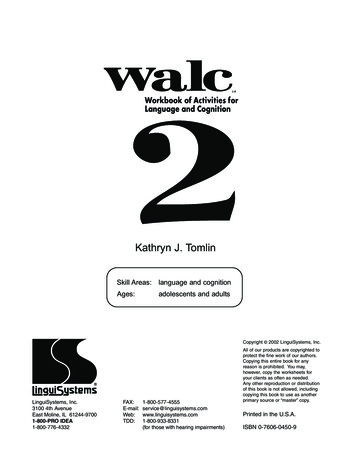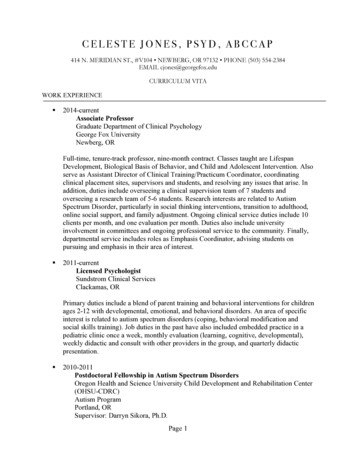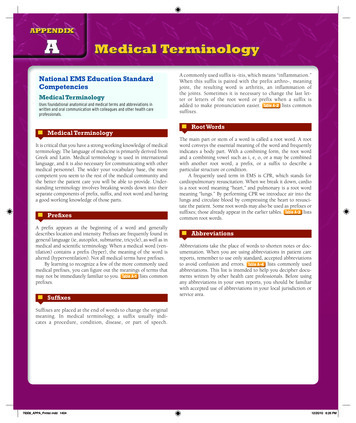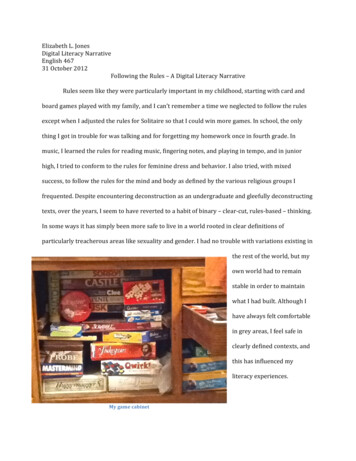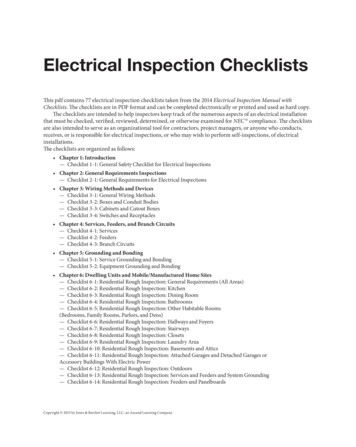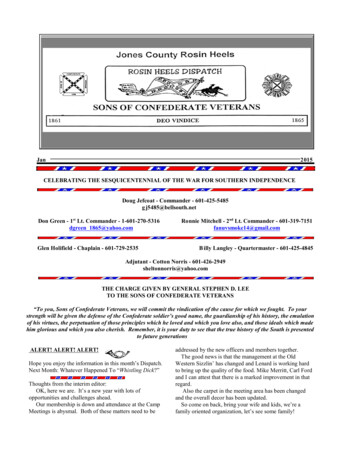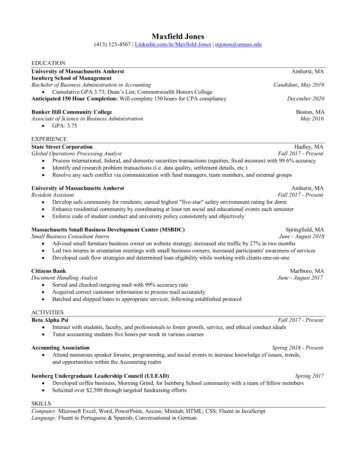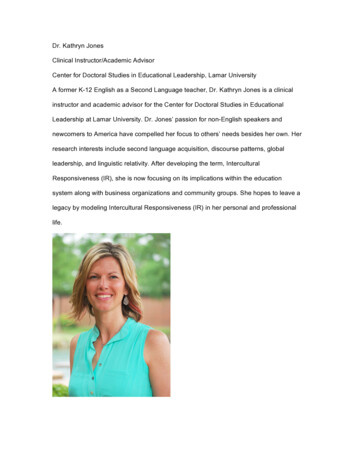
Transcription
Dr. Kathryn JonesClinical Instructor/Academic AdvisorCenter for Doctoral Studies in Educational Leadership, Lamar UniversityA former K-12 English as a Second Language teacher, Dr. Kathryn Jones is a clinicalinstructor and academic advisor for the Center for Doctoral Studies in EducationalLeadership at Lamar University. Dr. Jones’ passion for non-English speakers andnewcomers to America have compelled her focus to others’ needs besides her own. Herresearch interests include second language acquisition, discourse patterns, globalleadership, and linguistic relativity. After developing the term, InterculturalResponsiveness (IR), she is now focusing on its implications within the educationsystem along with business organizations and community groups. She hopes to leave alegacy by modeling Intercultural Responsiveness (IR) in her personal and professionallife.
Dr. Jason R. MixonAssociate ProfessorChair/Educational Leadership DepartmentDirector of Doctoral Programs in Educational LeadershipCenter for Doctoral Studies in Educational Leadership, Lamar UniversityDr. Jason R. Mixon is Associate Professor and Chair of the Educational LeadershipDepartment in the College of Education and Human Development at Lamar University.He is also the Director of the Doctoral Program for the Center for Doctoral Studies inEducational Leadership within the College of Education and Human Development atLamar University. Dr. Mixon has over twenty years of experience in education with manyof those years as a teacher, campus administrator, and central office employee. Hisresearch interests are in the areas of school reform, school leadership, online education,and culture issues. He has published over 45 journal articles, book chapters, and booksto his credit.
Six Easy and Beneficial Strategies for anInterculturally Responsive (IR) ClassroomAbstractThis scenario is a reflection of many classrooms throughout the United States. Thisheterogeneous population of students is linguistically, culturally, and educationallydiverse. Some are native born, and others have immigrated for various reasons. Thesereasons include new employment opportunities, a United States education, politicalrefuge, and family relocation to name a few. Our schools must learn to respond to thisdiversity by providing an Interculturally Responsive (IR) classroom (Jones, 2013) andlinguistically appropriate methods for language learners. The following strategies willassist in creating an Interculturally Responsive classroom and they are (a) provide sideby-side dual language opportunities, (b) assist with language transfer, (c) loosen updialogues, (d) make language learning interesting, (e) utilize graphic organizers, and (f)doodle. The aforementioned six strategies are easy and beneficial for any teacher toutilize and these strategies will assist the language learning situations in the classroom.Keywords: Intercultural Responsiveness (IR), awareness, sensitivity, responsiveness,reflection, language learners
Six Easy and Beneficial Strategies for anInterculturally Responsive (IR) ClassroomBeing an effective Interculturally Responsive (IR) teacher is an arduous task thatrequires perseverance and drive. It is one that requires teachers to be aware ofcultural differences, sensitive to cultural needs, and the willingness to respond tothe varied cultures. Teachers are expected to teach the student who enters theschool one day as a limited English speaker and the immediate need to startpreparing for the state assessment the next day, the student who understandsEnglish words but not comprehending what’s taught, and/or the student whoselanguage is constructed by his culture and as result is not American discourse.This aforementioned scenario is a reflection of many English as a SecondLanguage (ESL) programs throughout the United States. The following studentscenarios provide real world examples of the challenges that teachers face and theexamples consist of students from Mexico, Pakistan, and Syria. The student strugglesconsist of English language proficiency, reading and comprehension skill deficiencies,and English writing skills. The following best practices and scenarios were crafted afteran exhaustive review of the literature on language learners. An annotated bibliographywas aligned with the experiential practices of the authors to form a research andscenario based template to incorporate Intercultural Responsiveness (IR) into theclassroom. This heterogeneous population of students is linguistically, culturally, andeducationally diverse (Grantmakers for Education, 2013; Roy-Campbell, 2013). Someare native born, and others have immigrated to the United States for various reasons.Grantmakers for Education (2013) reported these reasons include new employmentopportunities, a United States education, political refuge, and family relocation to name afew. Our schools must learn to respond to this diversity by providing an InterculturallyResponsive (IR) classroom (Jones, 2013) and linguistically appropriate methods forlanguage learners.
Duncan and Gil (2014) reported that United States schools hosts an estimated4.6 million English language learners. These students come with diverse backgroundsand diverse language heritages. Spanish, Vietnamese, Chinese, Arabic and Hmong arereported as the most common languages of these students. In 2010, Limited EnglishProficient (LEP) individuals accounted for 25.2 million, or 9% of the United Statespopulation over age five (Pandya, Batalova, & McHugh, 2011). California, Texas, NewYork, Illinois, and New Jersey were the states that had the highest concentration of LEPindividuals (Pandya et al., 2011). Because of our country’s increase in language learnersand students of diverse backgrounds, providing the best program models andeducational opportunity is top priority (Honigsfeld, 2009). As educators, we must realizethat one size doesn’t fit all in today’s educational society.Teachers are expected to educate students from all backgrounds, from alllanguages, and specific content areas (Roy-Campbell, 2013). If given the appropriatetools and strategies, teachers can become aware, sensitive and then responsive (Jones,2013) of student’s academic and linguistic needs (Lucas, Villegas, & FreedsonGonzalez, 2008). Cultural awareness in the classroom will equip teachers to teach theircontent to all students including English Language Learners (ELL). Lucas et al. (2008)suggested that although teachers whose primary responsibility is to teach studentssubject matter cannot be expected to become experts on language, they can learn toidentify and articulate the special characteristics of the language of their disciplines andmake them explicit for their ELLs. The following strategies will assist in creating anIntercullturally Responsive (IR) classroom and they are (a) provide side-by-side duallanguage opportunities, (b) assist with language transfer, (c) loosen up dialogues, (d)make language learning interesting, (e) utilize graphic organizers, and (f) doodle. Theaforementioned six strategies are easy and beneficial for any teacher to utilize and thesestrategies will assist the language learning situations in the classroom.
Academic knowledge and conceptual knowledge learned in a student’s nativelanguage are able to transfer to a student’s target language while providing as a richresource for language acquisition (Cardenas-Hagan & Pollard-Durdola, 2007; Cummins,2000; Olsen, 2006). According to Lucas et al. (2008),Students who are academically strong in their first language already have abroad range of subject matter knowledge and skills to draw on while learning asecond language, thereby easing the burden of having to learn subject matterand a new language simultaneously. (p. 5)Research has indicated that reading skills and knowledge can transfer acrosslanguages (Goldenburg, 2008; Olsen, 2006). Goldenberg (2008) reported, “NationalLiteracy Panel and four other meta-analysis reached the same conclusion that learningto read in the home language promoted reading achievement in the second language”(p. 15). The research studies agreed that if a student has a strong foundation in readingthe home language then reading comprehension of the target language will simplytransfer (Goldenberg, 2008). Educators need to understand that language learnersshould be able to comprehend the concept in their target language (Goldenburg, 2008)then the concept can transfer with ease and congruency (Washburn, 2008). This transferof the home language to the target language should be the goal of teacher because itwill allow more time and focus to be invested in learning academic content. Miguel’sexample below exemplifies a couple of ways to assist teachers with language transfer.If he knows it in his native language, should he know it in English?Miguel came to the United States at the beginning of his tenth grade year. Hisparents decided that living with his aunt and uncle in the States would providehim more opportunities and a better chance of success. His posture and raisedchin portrayed a sense of determination and resiliency. He had a positive futureahead of him but a present lack of English skills accompanied him. Miguel wasconsidered to be a non-English speaker as he entered his new high school. HisESL teacher had high hopes for him, but was concerned of his English languageproficiency. With a strong foundation of his native language, Miguel started downthe road of success quickly. His language acquisition skills transferred to his
target language of English. As Miguel learned new concepts in English, hedepended on his strong foundation of his native language.a) Provide side-by-side dual language opportunities. Supplemental duallanguage material is extremely beneficial for language learners (Dewe, 2011).It gives the opportunity for students to recognize the concept in their nativelanguage and then it can be transferred to their target language. Alsopromoting literacy by creating dual media books (Cummins, 2005) is a wayfor students to visualize the parallel between languages.b) Assist with language transfer. Teachers should assist in the transferringfrom the native language to the target language by recognizing that transfer isnot automatic (Goldenburg, 2008; Olsen, 2006). Many times allowingstudents to recognize cognates or by providing visuals to confirm the learnedconcept will assure the language learner.Assisting students in transferring languages from the home language to thetarget language requires teachers to be aware of the linguistic background of the studentand sensitive to the linguistic needs. Awareness of the student’s home languageproficiency as well as the communication and academic skills of the target languageshould be known by the teacher (Goldenburg, 2008). It shows the language learner thattransferring languages is possible in order to understand the “comprehensible input”(Krashen, 1981) of the teacher.In his seminal work, Krashen (1981) supported that language isn’t simplylearned, it must be comprehended by the language learner. The message must becomprehended by the language learner (Krashen, 1981, Olsen, 2006). Krashen (1981)suggested that language learners acquire their target language by hearing andunderstanding messages that are slightly above their language proficiency. He called it“comprehensible input 1” (Krashen, 1981). In his continued research, Krashen (1985)
claimed by obtaining comprehensible input a language learner can understand themeaning of the message and focus on semantics at a later point in the process. Dewe(2011) and Grantmakers for Education (2013) stressed the importance of creatingcontent objectives that were clear, obtainable, and comprehensible. Shamsha’s examplebelow exemplifies a couple of activities to invite comprehensible input into theclassroom.I taught the lesson, isn’t that enough?Shamsha, a 5th grader, from Pakistan began school in the United States whenshe was in 2nd grade. When the ESL teacher met her, Shamsha’s speaking andwriting skills were proficient in English. However, her reading skills were lacking.She could pronounce all the English words that she was reading, however shecouldn’t comprehend their meaning. Shamsha expressed that she couldunderstand the words spoken by the teacher but didn’t understand the lessonbeing taught. Her ESL teacher talked to her content teacher who replied, “Itaught her the lesson, isn’t that enough?” Afterwards, the ESL teacher workedtowards making the content understandable for Shamsha. The information thatShamsha was learning had to be comprehended for it to be beneficial.c) Loosen up dialogues. Dialogues don’t have to be only academic; encouragesocial dialogues as well. Students can be creative in their words andresponses within the dialogue. It’s important to adapt the message to thelanguage learner’s needs (Haynes, 2005). Dialogues should include highfrequency words and words that students comprehend the meaning. Even ifthe dialogue isn’t advanced, it’s okay.d) Make language learning interesting. Learning a language can beconsidered boring if the teacher isn’t innovative and creative. The focus shouldbe on comprehensible (Grantmakers for Education, 2013) input that isinteresting. It’s easy to get real world input that is interesting but notcomprehensible (Krashen, 2013). Teachers should find out about the likes anddislikes of their language learners and embed them into the instruction.
Sensitivity stems from being aware of a language learner’s needs (Sato, 2014)and then being willing to mold instruction around those needs (Jones, 2013). Learningabout the interests of the students is a way to be sensitive while being responsive(Community HealthCorps, 2008). It’s a skillset that allows you to learn about others andhow to better them in our communities (Community HealthCorps, 2008, Vincent,Randall, Cartledge, Tobin, & Swain-Bradway, 2011). Respond by understanding thatculturally diverse students can think, speak, and write in different arrangements than thesocially dominate culture. Their organization of thoughts could be different than those inmainstream American schools.Language learners write expository text using their structure of their nativelanguage and cultural background (Kaplan, 1972). According to Kaplan (1972), thediscourse pattern of a language learner is the logical arrangement of ideas. MontanoHarmon (2001) presented that a student’s literacy skills are connected to the student’sdiscourse pattern. He argued that if students don’t know the expectations of the standardAmerican English discourse then educators can’t expect them to produce them inexpository texts. It is vital to a language learner’s education for the teacher toacknowledge the student’s home and academic discourse because discourse that isspoken at home varies from the dominant assessment driven curriculum (Mays, 2008).Aziz’s example below exemplifies a couple of ways to assist teachers with discoursepatterns of language learners.He lives in America, shouldn’t he write like one?Aziz came to the United States at the beginning of his 7th grade year. His familymoved from Syria because their home country was in turmoil and safety was acritical issue. His extended family and their occupations were in danger. HisEnglish skills were adequate for his new U.S. school, however his English writingskills needed improvement according to American language proficiencyguidelines. When his writing skills were assessed, he scored as a Limited EnglishWriter. This result wasn’t because of the lack of English vocabulary but becauseof the structure of his written English language discourse. As Aziz created his
written language in his new target language, his English writing skills becamemore proficient and while reflecting more of an American writer.e) Utilize graphic organizers. Teachers can supply graphic organizers forwriting assignments in all content areas (Lucido, Leo, & Boatright, 2012).“Venn diagrams, graphs, and timelines help students clarify concepts andunderstand causal relationships and trace the sequence of events by askingthem to organize ideas visually” (Lucas et al., 2008, p. 10).f) Doodle. Allow students to draw little pictures of their learning objectives(Montano-Harmon, 2001). Students can make foldables that include words,definitions, pictures and the how to use the word in a sentence. Doodles givewords meaning (Ensminger, 2010) with the help of pictures.Communicating via text or spoken language can be difficult for languagelearners. The complexity of culture as related to intercultural communication can bedifficult because language discourse reflects culture and culture is unique (Wang & Lui,2007). Teachers who are aware of diverse discourse patterns and are interculturallysensitive to language learners act beyond cultural circumstances (Sinicrope, Norris, &Watanabe, 2007). They are becoming Interculturally Responsive (IR).Teachers need to focus on how to adapt materials, implement culturallyresponsive lesson plans, and promote learning (Newman et al., 2010). Grant and Gillette(2006), Gur (2010) and Ward and Ward (2003) agreed that being a culturally competentteacher suggests being responsive to students from all cultures, ethnicities, andlinguistic backgrounds while valuing their cultural heritage. Aponte-Soto et al. (2014)claimed that being culturally responsive is an implementation process that is a reflectivepractice to understanding one’s own culture while relating to another culture. Teachersneed to make reflections of their own cultures while respecting other perspectives apriority (Han & Thomas, 2010).
In conclusion, Miguel, Shamsha, and Aziz acquired English from teachers withthe appropriate Interculturally Responsive (IR) skillset. Their stories, linguisticbackgrounds and academic hurdles reflect the students of today’s classroom. Theseeasy and beneficial strategies for an Interculturally Responsive (IR) classroom will helpany teacher assist with language learning situations. Teachers of culturally responsiveclassrooms want to educate all students despite different cultural backgrounds(Montgomery, 2001) while Interculturally Responsive (IR) classrooms educate allstudents while being culturally aware, sensitive and most importantly responsive (Jones,2013) through reflection.
ReferencesAponte-Soto, L., Grant, D. S., Carter-Johnson, F., Colomer, S. E., Campbell, J. E., &Anderson, K. G. (2014). Championing culturally responsive leadership forevaluation practice. In P. Collins & R. Hopson (Eds.), Building a new generationof culturally responsive evaluators through AEA’s Graduate Education DiversityInternship program. New Directions for Evaluation, 143, 37-47.doi:11002/ev.200920Cárdenas-Hagan, E., Carlson, C., & Pollard-Durodola, S. D. (2007). The cross-linguistictransfer of early literacy skills: The role of initial L1 and L2 skills and language ofinstruction. Language Speech and Hearing Services in Schools, 38(3), 249–259.Community HealthCorps (2008). Prescription for success: Community HealthCorpsMember Training. Retrieved from www.communityhealthcorps.comCummins, J. (2000). Language, power and pedagogy: Bilingual children in the crossfire.Clevedon, England: Multilingual Matters.Cummins, J. (2005, September). Teaching for cross-language transfer in dual languageeducation: Possibilities and Pitfalls. Symposium conducted at the TESOLSymposium on dual language education: Teaching and learning two languagesin the EFL setting of Bogazici University, Istanbul, Turkey.de Jong & Harper. (2005). Preparing mainstream teacher for English-language learners:Is being a good teacher good enough? Teacher Education Quarterly, 32(2), 101124.Duncan, A. & Gil, L. (2014, February 19). English learners as asset for global,multilingual future. Los Angeles Daily News. Retrieved e-arne-duncan
Center for Doctoral Studies in Educational Leadership, Lamar University Dr. Jason R. Mixon is Associate Professor and Chair of the Educational Leadership Department in the College of Education and Human Development at Lamar University. He is also the Director of the Doctoral Program
